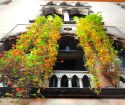Every season has bragging rights about something. Winter has snow and trees decorated in white. Fall has frost on the pumpkins and fall vegetables. Summer has sun and the search for shade trees to lounge under while sipping sweet tea. Spring is lucky. It is the best season for every imaginable color. Color that will change our moods and brighten our homes.
Color comes from hundreds of flowers and plants. Flowers that have a history of appreciation over hundreds of years deserve a spot in your yard. Nasturtiums are one such flower that traveled to Europe around 1569 from South America. This flower was named after rounded shields of armor by Swedish botanist, Carl Linnaeus. The Romans, after a victory, would erect a trophy pole and hang the armor and the weapons of the losing army. Linnaeus viewed nasturtium leaves as the shields and the flowers as the blood-stained helmets. As the 16th century emerged the nasturtium became known as a symbol of patriotism.
Old-fashion flowers have common denominators. Nasturtiums follow suit. They have beautiful, long lasting fragrant flowers throughout the spring, summer, and fall. The leaves have interesting textures that provide a peppery flavor in salads. Yes, they are edible! Leaves and flower petals are high in vitamin C and are believed to increase the immune system. The plants do well in poor soils and are easy to start from seed. Their fragrances made nasturtiums a favorite for ladies to carry to ward off unpleasant odors in their “tussie mussie” (posey) bouquets. A flower with such a long history has a well-earned spot in a spring garden.
There are three types of nasturtiums; dwarf, semi- trailing, and climbing. Dwarf varieties are bushy and compact. Our local nurseries carry the dwarf varieties such as Alaska Mix with variegated leaves and flowers in red, yellow, and orange, Empress of India with red flowers and blue undertone leaves, and Jewel Mix with semi to double flowers in yellow, red, and orange.
Semi trailing varieties may reach to a length of several feet, perfect for hanging baskets. The Gleam series, All-American Selection winner in 1935, has double flowers in yellow, red, and orange. Best choices are Troika Red and Troika Orange. Popular during the Depression, the Gleam series was discovered in Mexico in a convent garden.
The climbing varieties have single flowers on six to eight-foot strong vines. The flowers are fragrant in the crimson, red, orange and yellow tones. Varieties to look for are Jewel of Africa and Tall Trailing Mix.
Happy nasturtium plants want full sun in sandy loam soil. Save all the fertilizers, overly rich soils, and excess water for picky plants. If you treat them too well, you will have lots of plant and few flowers. Nasturtiums are great plants for teaching children about seeds. The seeds are easy to handle and will come up in 7 to 10 days. To make it easier for the seeds to start use a fingernail file to remove a small portion of the hard covering on the seed.
If you are fighting pests in your garden nasturtiums will be your fighting force. By interplanting nasturtiums with your vegetables, you will notice fewer aphids, whiteflies, caterpillars, cucumber beetles, and borers. Nasturtiums are dually beneficial. While chasing away bad bugs, nasturtiums will call the good bugs to come on over, attracting beneficial predatory insects for protection.
The perfect old-fashion flower covers all the marks; easy to grow, beautiful, tasty to eat, and with a remarkable history. Add joy to your home with all the blooming flowers in mounds of colors lasting for many months. The perfect flower for spring and your tussie mussie!
Julie Silva is a University of California Cooperative Extension Master Gardener of Tuolumne County.
UCCE Master Gardeners of Tuolumne County can answer home gardening questions. Call 209-533-5912 or go to: http://ucanr.edu/survey/survey.cfm?surveynumber=7269 to fill out our easy-to-use problem questionnaire. Check out our website at: http://cecentralsierra.ucanr.edu/Master_Gardeners/ You can also find us on Facebook.


